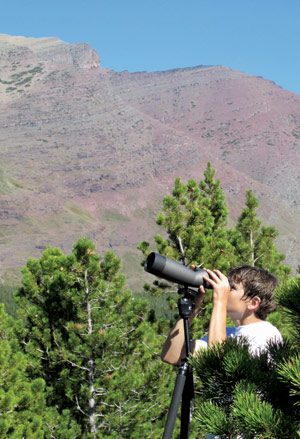On Sept. 19 students from Flathead High School’s environmental systems and societies class spotted two mountain goats and two pika near Many Glacier.
“We were pretty stoked,” said Chandler Escalante.
Students from Flathead headed to Glacier National Park last week to take part in the Citizen Science Program, which gathers data for various research projects. Environmental science teacher Lori Ortley said it’s an invaluable experience for her students.
“They get to see how real science works,” she said.
Flathead has offered the environmental systems and societies class for seven years, according to teacher Renee Cordes. Her students have partnered with Glacier National Park for the last three years. The class studies the effects humans can have on the world around them in different environments. Last year students ventured to the Oregon coast and next spring they will head to Moab, Utah.
“It’s a lot of fun,” she said. “It gets the kids excited because they’ve been taking notes and reading books in classrooms and it becomes real.”
Escalante, 16, said spending the day in Glacier was much better than spending it in a classroom. Last week, students boarded a bus and headed to the east side of the park.
Near Two Medicine, the students hiked two miles into the wilderness to gather data. During the first part of the day, Escalante’s group searched an area for evidence of pika, a small rodent that lives under boulders. After that, the groups switched and studied the area’s mountain goats. To do that, the students scanned a landscape with binoculars. Madelaine Walker, 16, said it was harder than it sounds.
“There were a lot of white rocks that looked like goats, but they weren’t,” she said.
 |
|
A Flathead High School student scans a mountainside looking for goats as part of a data gathering trip in Glacier National Park. | Photo courtesy of Renee Cordes |
Walker, a junior who will be graduating in the spring, said she plans on studying business at college, but the environmental studies class has sparked her interest in science. She plans on returning to the park and volunteering more data for the Citizen Science Program.
“It’s really awesome and I love to get the opportunity to do hands-on stuff, rather than just looking at a book,” she said.
Cordes said the students’ data enables them to form a hypothesis about animal populations and also helps the park service in its research. Even when the students don’t see anything, that information has a purpose.
“Zeros are just as important, that’s what we tell the students, because then they have to find out why,” she said.
For more information about Glacier National Park’s Citizen Science Program visit www.nps.gov/glac/naturescience/ccrlc-citizen-science.htm.